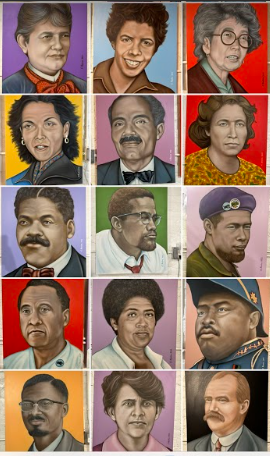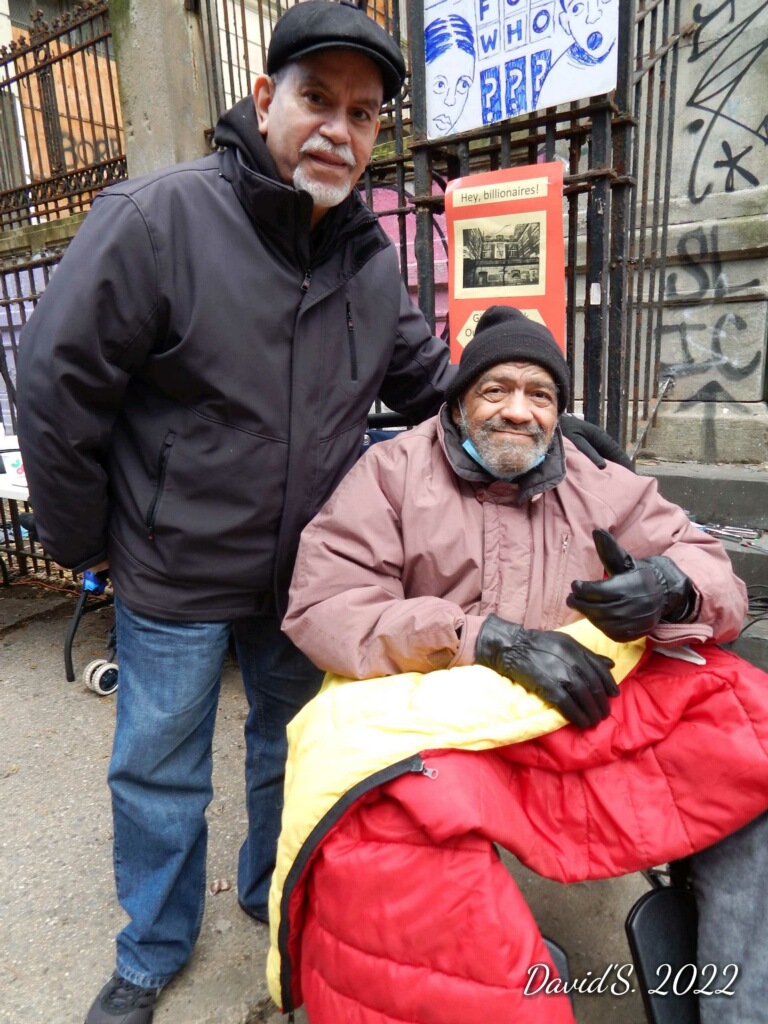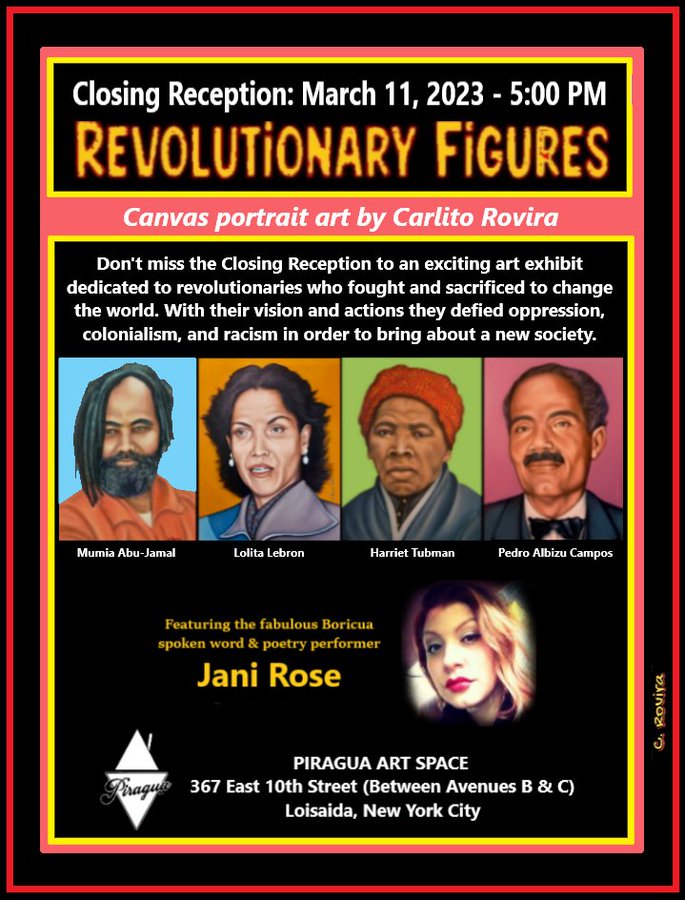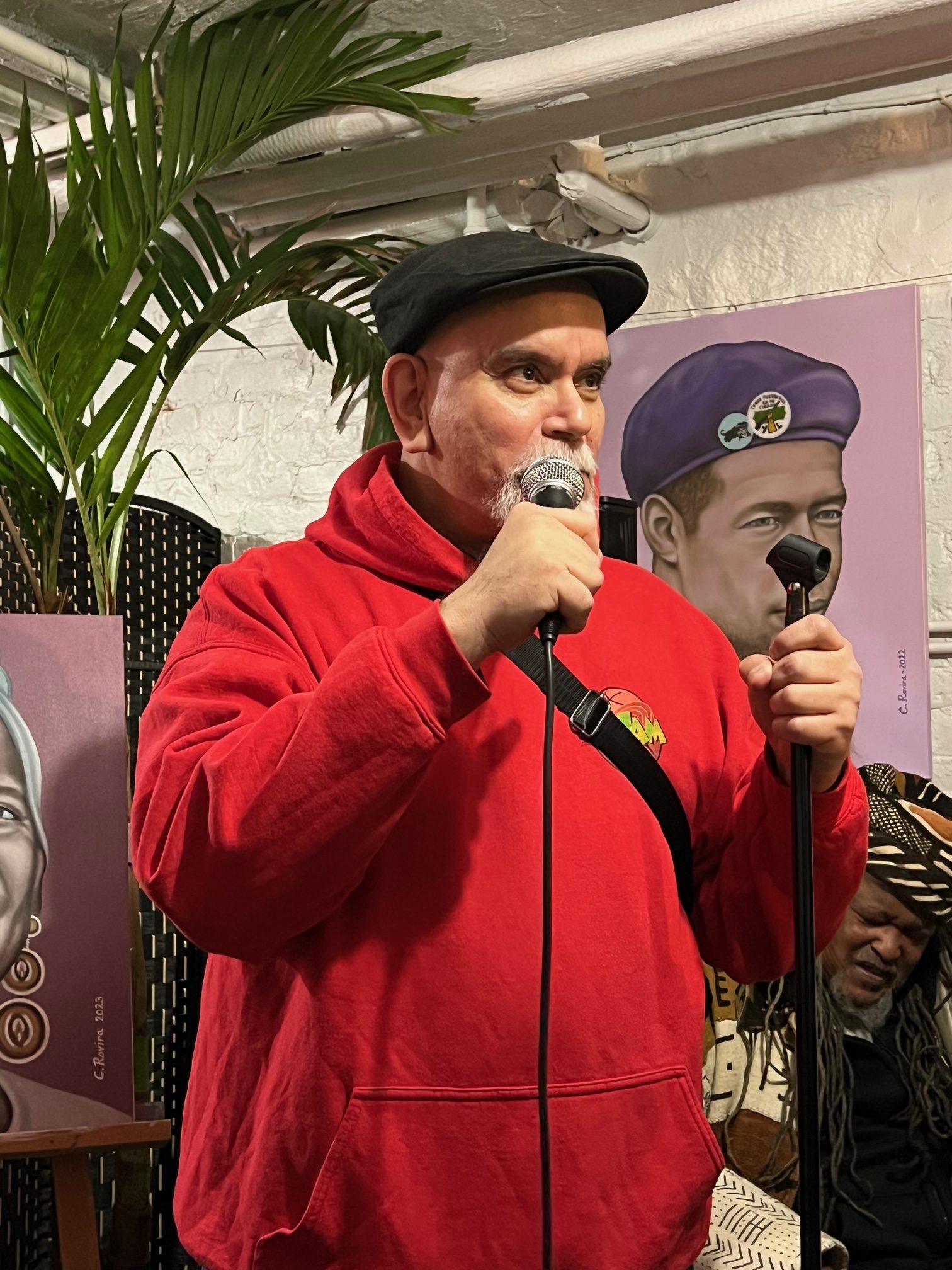BY BONNIE ROSENSTOCK | Carlito Rovira’s powerful portraiture art is dedicated to revolutionaries who fought and sacrificed to change the world. His solo show opened on Feb. 25 to an overflowing, into-the-streets crowd and will run until Sat., March 11, at Piragua Art Space, 367 E. 10th St., between Avenues B and C, across the street from the murals of Loisaida legends on the north side of the old P.S. 64 (former CHARAS / El Bohio).
Rovira was one of the original seven members of the New York chapter of the Young Lords. In a telephone interview, he affirmed that he is “an activist from birth,” and that each of the 16 figures on exhibit — “and there’s a whole lot more” — were against the status quo. “They were for social and economic change, anti-capitalist and in some cases pro-socialism,” he said.

The 24-inch-by-30-inch portraits in vivid acrylic tones include Puerto Rican nationalists, radical thinkers, 1960s and ’70s revolutionaries and international figures. There are five from the Puerto Rican national liberation struggle for independence, including Pedro Albizu Campos, Luisa Capetillo, Blanca Canales, Lolita Lebron and Lola Rodríguez de Tío.
“You go to history books in Puerto Rico, and you won’t find anything about them,” he declared. “Or, if you do, they will discard the revolutionary content of their lives.”
Rovira related that Campos was the first Puerto Rican to attend Harvard Law School and graduated with the highest grade point average in his class. He was mentored by James Connolly (also featured in the exhibit), who was an Irish Republican Army leader. Connolly asked Campos to write a draft of the constitution for a free Ireland.
De Tío helped found the Cuban Academy of Arts and Letters and designed the Puerto Rican flag, using the reverse colors from the Cuban flag. One of her poems became the lyrics to a revolutionary anthem, now discarded, yet the same music is used in the present-day anthem.
“Her version is still sung in Puerto Rico, but it’s not the official version,” Rovira noted.

Other figures include Yuri Kochiyama, a Japanese-American civil rights activist who was in an internment camp during WWII and was a close ally of Malcolm X; Patrice Lumumba, the first prime minister of the Democratic Republic of the Congo and leader of the Congolese National Movement, who was executed in 1961; Black nationalist Marcus Garvey; abolitionist Harriet Tubman; Bob Collier, leader of the Black Panthers’ Loisaida chapter and one of the Panther 21 arrested and eventually acquitted; Jose “Cha Cha” Jimenez, the founder of the Young Lords; Audre Lorde, Black lesbian writer; Arturo Alfonso Schomburg, a historian, collector and activist whose name graces the public library’s Harlem branch; and playwright Lorraine Hansberry.
Rovira, 70, was born and raised in the Lillian Wald public housing complex, at E. Sixth Street and Avenue D, the same block where the original CHARAS and the Nuyorican Poets Cafe were located. He went to school across from CHARAS and knew Chino García and Angie Hernandez (two CHARAS / El Bohio co-founders) as a youth. Rovira didn’t realize he knew David “Daso” Soto, Hernandez’s son and Piragua gallery’s owner, until contacting him about the idea of doing an exhibit. Rovira now lives in Harlem.
Although Rovira was already painting, he perfected the principles of portraiture during his six years in prison in New Orleans for aggravated battery, “a stupidity I committed,” he acknowledged. His teacher was Rex Anderson, an alcoholic who at the time was incarcerated for vagrancy. The Louisiana sheriff liked what they were doing and asked them to do a giant, 20-foot-tall portrait of the senior George Bush, which was displayed on a billboard.
“That inspired me to continue,” said Rovira.
Since Rovira didn’t know most of these people personally, he explained that he surrounds himself with photographs and then focuses in on the particular pose he’s going to use.
“I get a 3-D sense in my head by using different photographs,” he explained. “Most of them lived at a time when there were no color photographs. I had to do a lot of research and study gray tones, which would tell me what color that person was.”
He also uses a dry bristle-brush technique.
“I don’t stroke, I rub with the brush, with old brushes,” he said. “It’s like an old instrument is better than a new one.”

He credits his wife, Lisa B. Jones — calling her “my best adviser” — for teaching him about the relationship between the background and the object he’s painting.
“She doesn’t give a s— about hurting my feelings,” he said. “If she thinks something is off, she’ll point it out.”
The portraits sell for $300 each.
“I’m a people’s artist and make it reasonable for people to afford them,” Rovira stated. “I’m not trying to get rich from them. I’d rather work in McDonald’s than prostitute my art.
“What I would like to be remembered for is using my art to educate people,” he said. “The chances that young people are learning [elsewhere] about the people I paint is very unlikely. I get a kick using my art to fight.”
The exhibit closing on March 11, beginning at 5 p.m., will feature a performance by Jani Rose, a Boricua spoken word artist and poet, as well as music and other happenings. A portion of the sales is going to Piragua and to El Maestro boxing gym and educational center in the Bronx.
For more information contact Piragua Art Space at 917-582-2431.


The original Nuyorican Poets cafe was located at 505 East 6 Street, which is between Ave A and B. I lived a few doors down.